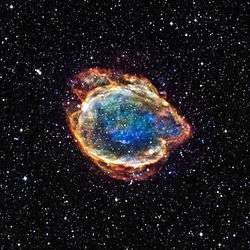All Sky Automated Survey for SuperNovae
| Survey type |
Astronomical survey |
|---|---|
| Target |
Supernova |
The All Sky Automated Survey for SuperNovae or ASAS-SN is an automated program to search for new supernovae and other astronomical transients. It has robotic telescopes in both the northern and southern hemispheres. Currently, it can survey the entire sky approximately once every day.[1]
Initially, there were four ASAS-SN telescopes at Haleakala and another four at Cerro Tololo, an LCOGT site. Twelve more telescopes were deployed in 2017 in Chile, South Africa and Texas, with funds from the Moore Foundation, the Ohio State University, the Mount Cuba Astronomical Foundation, China, Chile, Denmark, and Germany. All the telescopes (Nikon telephoto f400/2.8 lenses) have a diameter of 14 cm and ProLine PL230 CCD cameras. The pixels in the cameras span 7.8 arc seconds, so follow up observations on other telescopes are usually required to get a more accurate location.[2]
The main goal of the project is to look for bright supernovae, including the most powerful supernova ever discovered, ASASSN-15lh. However other transient objects are frequently discovered, including nearby tidal disruption events, Galactic novae (e.g., ASASSN-16kt, ASASSN-16ma, and ASASSN-18fv), cataclysmic variables, and stellar flares, including several of the largest flares ever seen. In July 2017 ASAS-SN has discovered its first comet, ASASSN1. It can detect new objects with magnitudes between 18 and 8.[2]
Objects discovered receive designations starting with ASASSN followed by a dash, a two digit year and letters, for example ASASSN-15lh.
References
- ↑ Dong, S.; Shappee, B. J.; Prieto, J. L.; Jha, S. W.; Stanek, K. Z.; Holoien, T. W.- S.; Kochanek, C. S.; Thompson, T. A.; Morrell, N.; Thompson, I. B.; et al. (January 15, 2016). "ASASSN-15lh: A highly super-luminous supernova". Science. 351 (6270): 257–260. arXiv:1507.03010. Bibcode:2016Sci...351..257D. doi:10.1126/science.aac9613. PMID 26816375.
- 1 2 Holoien, Tom; Stanek, Kris (5 January 2016). "ASAS-SN's (Assassin's) Homepage". www.astronomy.ohio-state.edu. Retrieved 19 January 2016.

